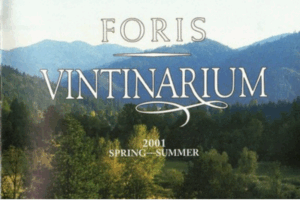
In the late 1990s and early 2000s, we produced a quarterly “zine” titled “Vintinarium”. Each edition featured a bit of industry news, updates from Foris vineyard, and of course, the latest wine releases and ratings.
We recently found an old hard drive that contained these PDF zines and we thought it’d be interesting to compare various aspects of the musings with our current thinking, now 25 years later.
Without further adieu, here is our first crack at it: Terroir.
The Foundation: Understanding Place
In the late 1990s, Foris Vineyards was already grappling with the fundamental question that drives all serious winemaking: how do you capture the essence of place in a bottle? A quarter-century later, that pursuit continues, but the landscape, both literal and figurative, has evolved in fascinating ways.
Looking back at Foris’ philosophy from the turn of the millennium, the winery was deeply committed to expressing their unique Oregon terroir through a balance of scientific understanding and traditional intuition. The focus was clear: let the land speak through the wine, using both modern analytical techniques and generations-old winemaking wisdom.
The original vision emphasized how even closely planted vineyards could produce distinctly different wines due to subtle variations in soil composition and microclimate, a principle that would prove prophetic as Foris expanded their vineyard holdings over the following decades.
Climate Change: The Great Terroir Shifter
Then: In 2001, Foris was working with established weather patterns and focusing on understanding how their specific sites expressed themselves within those predictable cycles.
Now: According to current winemaker Stephanie, while the fundamental elements of terroir (site, soils, elevation, and plantings) remain unchanged, weather has become the great variable. “Less rainfall has changed the makeup of the forest near us, but it has also tended to create smaller clusters with more concentration in the drier years and more interesting wines,” she explains.
This climate evolution has actually benefited their dry-farmed Pinot Noir, creating wines with greater intensity and complexity. What once might have been seen as challenging conditions have become opportunities for enhanced expression of place.
Expanding the Canvas: New Sites, New Stories
Then: The original Foris vineyards were the sole storytellers of their terroir, with winemakers learning to interpret the voice of their established sites.
Now: The addition of new vineyard sites since 2000 has dramatically expanded Foris’ terroir vocabulary. Stephanie notes that their Chardonnay now comes largely from “a new planting on the Timmer Ranch since it tends to have more interesting flavors and concentration due to the rocky site,” while still incorporating fruit from the Gerber Vineyard for its later-ripening characteristics.
Each site has revealed its own personality: “the differences are largely due to elevation differences and the soil’s ability to hold water, which affect the ripening profile of the fruit.” This expansion hasn’t diluted their terroir expression—it has enriched it, giving the winery a broader palette of site-specific characteristics to work with.
The Human Element: Continuity Through Change
Then: The Spring 2001 Vintinarium emphasized the crucial balance between scientific methodology and winemaker intuition, the human interpretation of place.
Now: Under Stephanie’s guidance, this philosophy has evolved into something more pragmatic yet equally respectful of place. “Winemaking is a pretty site-specific task, especially at a place like Foris that is focused on making estate wines,” she explains. “Our goal is always to make the most pleasing wines from the year’s growing conditions.”
Stephanie’s approach represents a maturation of the original Foris philosophy. Rather than imposing a personal style, she sees her role as an interpreter and steward: “My future plans are to continue to broaden our knowledge of our site, and improve consistency and quality with the changing weather.”
The Wisdom of Age
Perhaps the most significant change over the past 25 years isn’t in philosophy but in the vines themselves. Stephanie notes that “vine age has also had a positive effect on the sites planted 20 years ago, since those components are less ‘simple’ in how they present themselves.”
This evolution speaks to one of wine’s greatest truths: terroir expression deepens with time. The vines that were young and straightforward in 2001 now contribute layers of complexity that couldn’t have been achieved through winemaking technique alone.
Looking Forward: Tradition with Adaptation
The Foris story from then to now isn’t one of dramatic reinvention but of thoughtful evolution. The core commitment to expressing terroir remains unchanged, but the tools, understanding, and even the terroir itself have evolved.
Stephanie’s vision for the future maintains this continuity: “I hope that our wines will be known as good versions of the varietal, made traditionally, at our price point.” It’s a philosophy that honors both the original Foris vision and the realities of farming and winemaking in an era of climate change.
Twenty-five years later, Foris continues to prove that the best expressions of terroir come not from rigid adherence to the past or wholesale embrace of change, but from the thoughtful adaptation of enduring principles to evolving conditions. The place may be speaking with a slightly different voice than it did in 2001, but Foris is still listening—and translating what they hear into wines that capture the essence of their unique corner of Oregon.

